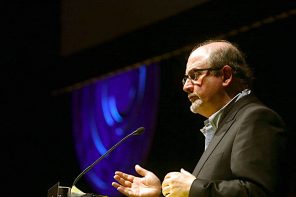Normally I have fun poking holes in the idiocies of Islamophobes. However, I must now, with heavy heart, go after the misuse of the term by a friend. Fatemeh Fakhraie of Muslimah Media Watch (and AltMuslimah, and Devil’s Advocate, etc.) uses the term “Islamophobia” inappropriately in her analysis of a recent article in the Washington Post by Jim Hoagland.
Interestingly, Dan Varisco of Hofstra University recently published a piece questioning the broad nature of the term “Islamophobia” and whether it was the best term to describe those who actively hate Islam, as opposed to those who simply fear it out of ignorance. He says:
Fear is understandable; anything new is prone to be misunderstood, especially when the issue is about how to believe in God. Christians and Jews came to fear Islam because it was a rival, one with powerful political muscle through the 16th century. Fear, however, is not the problem. The major stumbling block for peaceful coexistence between rival faiths or ideologies of any kind is hatred. It is one thing to reject the message of Islam on an intellectual level, but it is quite another to so detest the religion and the people who follow it so much that violence erupts. …Phobias are real problems, but I can be afraid of heights or enclosed spaces without ratcheting it up to outright hate.
My initial response to Dr. Varisco was that the term is wrong in its literal meaning, but I believe it has taken on a generally understood meaning that gives it value. However, that does not mean that I disagree with the idea that we need more nuance to the types of Islam-bashing happening.
What Ms. Fakhraie’s article does is actually extend the term into novel meanings that show how Dr. Varisco’s suggestion is right, the term is so broad that it truly has no meaning. Ms. Fakhraie’s critique of Jim Hoagland’s article is right on many points, but often misses the causes of his choice in language. In other instances, there seems to be a misreading of the article. For example, she says:
[Hoagland] paints a picture of a place where men are evil and women are victims. …Instead of placing the blame on local manifestations of patriarchy, he hurls blame at local Taliban, not minding that his condemnation falls like misguided bombs on innocent men who have nothing to do with the Taliban or the public whipping in Pakistan.
Yet, he does imply it is a question of patriarchy, which the Taliban is leveraging:
the desire of Pakistani and Afghan men to be left in peace to deal with their womenfolk as they see fit. There may be no more important recruiting tool for the Taliban and other Islamic extremist organizations.
He is actually fairly nuanced in his presentation of the Taliban and distinguishing them from the way most Muslims practice their faith, avoiding the pitfall of equating the Taliban with Muslims, which would arguably be Islamophobic. While I would have preferred to see the qualifier “some” in front of “Pakistani and Afghan men,” the gist of his article is not one of gross generalizations.
She continues and attacks his use of “warrior culture.” Once more, this use has nothing to do with Islam, but the idea of “martial races” imported during British colonial rule, where certain groups of people were better soldiers because they had a warrior culture. The Sikhs are often held up as an example of a martial race.
Finally, she talks about Hoagland’s comparison of Swat to Turkey, but seems to miss his point about urbanity and governance. The comparison was not to “Westoxification” in Turkey. Hoagland actually compares Swat to Turkey and Indonesia, yet Ms. Fakhraie ignores the latter comparison. Hoagland is not being Islamophobic, nor is he even setting up a construct of Good Muslim, Bad Muslim.
Perhaps the closest Hoagland gets to Islamophobia is when he says:
All religions are absorbing the shocks of globalization. But none has felt more besieged than Islam as the flow of people, goods and instant communications across borders perturb or limit its deep reach into gender relations and family structures. And none has produced as violent a backlash from some of its adherents.
Once more, one has to look at the nuance he’s including. It’s not the only faith dealing poorly with globalization, but it is the only faith that is responding with violence to the US. The first part of that argument is fine, the second is clearly not. The recent DHS report on right-wing extremist groups shows how religion is being mobilized in the service of violence against the US — and it’s not all Muslims. The Southern Poverty Law Center has been tracking groups like this for years.
Generally, Hoagland’s piece is one of the better treatments of the issue regarding those who would speak in the name of Islam. Although he does use some colonial framing and language, to blame the deficiencies of his article on Islamophobia weakens the word and does not actually serve to point out how there are various languages of power and control with which we must contend.




